BUILDING RISK KNOWLEDGE
WHY THE FOUNDATION WAS BORN? >
WHY THE FOUNDATION WAS BORN? >
DISASTERS ARE NOT NATURAL, they are socially built, due to lack of preparation, prevention, mitigation work, education and monitoring. They are natural risks or hazards that impact vulnerable societies. Knowledge help reducing social and structural vulnerability in order to have more resilient societies!
In the Earth’s interior, the only parts composed of rock in a liquid state are the outer core and the small (on the scale of the planet) molten zones feeding the volcanoes. The asthenosphere is ductile (able to deform) but all other layers are rigid and brittle.
The Earth’s lithosphere is divided into tectonic plates, the result of the cooling of the Earth since its formation: like a lava lake where the surface cools before the inner parts, and cracks. The ability of the asthenosphere to deform allows these plates to form at ocean ridges, move slowly across the surface of the globe and sink into the mantle at subduction zones.
And what happens along the plate boundaries? Depending on the direction in which neighbouring tectonic plates are moving, their boundaries are converging or diverging. At ocean ridges, convection movements in the mantle bring up hot rock from the depths. When the pressure is low enough (due to the upwelling), the rock melts and feeds the formation of the oceanic crust. At subduction zones, the older oceanic plate has become denser and, driven by its own weight, sinks into the less dense asthenosphere.
Because volcanoes are everywhere on Earth, but not just anywhere! The vast majority of them are located along plate boundaries, and this is not by chance. Only hot spots (such as Hawaii or Reunion Island) contradict the rule and appear in the middle of the plates. Why is this? We don’t really know, but the magma comes from very deep down: at the boundary between the mantle and the core. In any case, all these volcanoes are a bit like safety valves for the Earth, releasing energy in the form of heat from the interior of the planet to the surface.
So by definition, a volcano is the product of magma coming to the surface. But why do volcanoes erupt?
At depth, the chemical, pressure and temperature conditions may be right for the solid rock in the mantle to melt. For example, in a subduction zone, the oceanic crust, rich in so-called ‘hydrated’ minerals (acquired during hydrothermal reactions at the bottom of the ocean), sinks into the mantle. At a given depth, these minerals become unstable and release their water, which rises to create the ideal conditions for the mantle to melt.
These reactions occur at approximately the same depth along the entire length of the subducted crust. This is why, for example, the Andean volcanoes are aligned at a relatively constant distance from the Pacific coast, forming a volcanic arc.
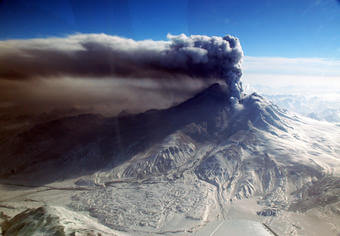
Redoubt volcano with minor ash eruption. Photograph taken during observation and gas data collection flight by AVO staff March 30, 2009.
It is important to know that on our planet, the deeper you go, the higher the temperature and the higher the lithostatic pressure (pressure exerted by the column of rock above a given point). The increasing temperature would tend to melt the rock, but the pressure prevents this. Only sometimes, a volume of mantle rises from the boundary with the core. This solid but deformable plume accumulates under the lithosphere without having time to cool down, while the pressure decreases without delay. The heat of the plume then melts the rock of the lithosphere: this is what we call a hot spot!
What happens inside the crust? From its source, magma can follow a direct path to the surface, but often its path is more complicated. Magma sometimes gets stuck in the crust (< 60 km deep) and accumulates in a magma reservoir (or magma chamber).
Like the liquid in a bottle of champagne, magma contains dissolved gas under pressure. If the chamber fractures (e.g. if the pressure in the reservoir becomes too high and breaks the roof of the chamber), the gas is decompressed and separates from the magma, forming bubbles: this is called exsolution.
In its sudden ascent, the gas drags the magma with it towards the surface and, in the same way as for a bottle of champagne uncorked suddenly, it is the eruption!
Sometimes, during the most violent eruptions, the magma chamber can empty itself, its roof can collapse and form a caldera.
But this is not always the case. Most of the time the magma chamber only partially empties and fills up again, by injection of magma from a deep source, and we go from stage 1 to stage 2 continuously.
But that’s not all! On the same volcano, eruptions are sometimes separated by hundreds of years… During this time, what happens in the magma chamber? The magma undergoes transformations.
Three main mechanisms are involved:
Contamination by the surrounding rock of the magma chamber (black arrows)
Injection of new magma (orange arrow)
Fractional crystallisation: a process where the crystallisation of minerals mobilises certain chemical elements rather than others.
The composition of the magma therefore changes gradually and an eruption occurring at a different time in this evolution will have a different composition. And this can lead to more or less violent volcanism.
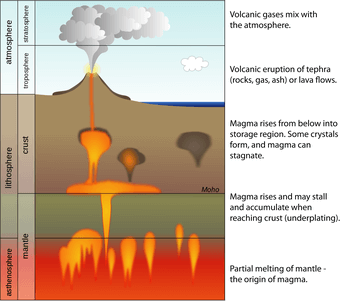
Scientists have identified 161 volcanoes in the United States that will most likely erupt at some point in the future. Most of these volcanoes are located in Alaska, a state where eruptions occur almost every year. The remaining volcanoes are located in the American West and Hawaii (see our volcanic activity map for their locations). Kīlauea volcano, on the island of Hawaii, is one of the most active volcanoes on the planet. It has been erupting almost continuously since 1983!
There are about 1,500 potentially active volcanoes in the world, not including volcanoes under the oceans. About 500 of them have erupted in the last 100 years. Many of these are located around the Pacific Ocean, in what is known as the “Ring of Fire”.
If we go into detail, we can define several types of volcanoes according to the type of activity and the power of the eruptions. For this purpose, a scale had to be created: Volcanic Explosivity Index (VEI).
The place of an eruption on this scale depends on the volume of the eruption and the height reached by the volcanic projections.
(For example, a VEI 5 eruption, such as the one that destroyed Pompeii on the slopes of Mount Vesuvius, only occurs statistically every few hundred years.
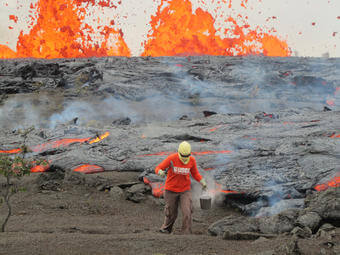
Cinder cones are the simplest type of volcano. They are made of small pieces of solid lava, called cinder, that are erupted from a vent. The ground shakes as magma rises from within the Earth. Then, a powerful blast throws molten rocks, ash, and gas into the air. The rocks cool quickly in the air and fall to the earth to break into small pieces of bubbly cinder that pile up around the vent. They accumulate as a small cinder cone that can be as high as a thousand feet above the surrounding ground. If the wind is blowing during the eruption, the cinder is carried downwind before it’s deposited into an oval shape. Eruptions that form cinder cones also feed lava flows that spread outward from the eruptive vent. When you climb a cinder cone you can usually find the bowl-shaped crater marking the location of the vent. If eruptions of cinder and lava flows happen repeatedly from the same vent, the overlapping layers can form a composite volcano (stratovolcano). When looking at a map, you will find that thousands of cinder cones exist in western North America and other volcanic areas of the world.
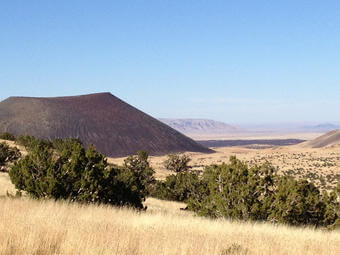
East Summit is on the left skyline, and North Summit, to its right, is topped by an ice-filled crater from which a blocky dacite lava flow extends 1 km toward the camera. Central summit, the highest point on the mountain at just over 7,100 ft (2,165 m) rises on the background skyline, 7 km southwest of North Summit. Alaska Volcano Observatory photo
Some of the Earth’s grandest mountains are composite volcanoes—sometimes called stratovolcanoes. They are usually tall with steep even sides and are made out of repeating layers of lava flows, volcanic ash, cinders, blocks, and volcanic bombs. Some composite volcanoes rise over 8,000 feet above their surroundings, but they reach much higher elevations when compared to the level of the sea (called above sea level). Ojos del Salado in Chile is the tallest composite volcano on Earth with a summit elevation (height above sea level) of 22,615 feet; the tallest in the U.S. is Mount Rainier in Washington State with a summit elevation of 14,410 feet. Some of the most famous and beautiful mountains in the world are composite volcanoes, including Mount Fuji in Japan, Mount Cotopaxi in Ecuador, Mount Shasta in California, Mount Hood in Oregon, and Mount St. Helens in Washington
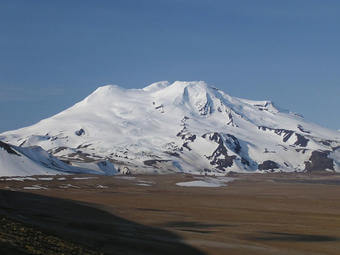
Shield volcanoes are built almost entirely of fluid lava flows. Lava pours out of vents in all directions, either from the summit (top) or along two to three rift zones (fractures) that radiate out from the summit like spokes on a bicycle wheel. As lava flows overlap one another, they construct a broad, gently sloping dome shape that from far away appears similar to a warrior’s shield. Shield volcanoes build up slowly by the growth of thousands of lava flows that spread widely over great distances, and then cool as thin sheets. On Earth, some of the most massive volcanoes are shield volcanoes. In northern California and Oregon, many shield volcanoes are up to 3 or 4 miles wide and as tall as 1,500 to 2,000 feet. The Hawaiian Islands are made of a chain of shield volcanoes including Kilauea and the world’s largest active volcano, Mauna Loa. Looking at pictures of volcanoes, you can usually identify them by shape as being a shield volcano or stratovolcano.
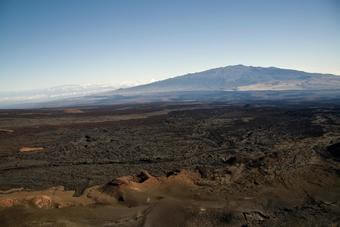
Shield-volcano Mauna Kea viewed from the northern slope of Mauna Loa (cinder cones in the foreground) shows off its broad shield shape. The bumps on its profile are large cinder cones.
Lava domes are technically lava flows, but they contain lava that is too thick to flow away from the vent. Lava squeezes out of the vent and accumulates as a giant pile over and around the vent. Some domes form pointy spines, while others appear as a giant muffin, as opening flower petals, or as steep-sided stubby flows or tongues. Lava domes often grow within craters or upon the flanks of large steep-sided composite volcanoes. Lava domes can be dangerous. They grow largely by expansion from within. As fresh magma fills the inside, the cooler and harder outer surface shatters and spills hot rock and gases down the mountainside. The circle-shaped Novarupta Dome that formed during the 1912 eruption of Katmai Volcano, Alaska, measures 800 feet across and 200 feet high. This dome was one of the last squirts of lava to emerge during a much larger and long-term eruption. The eruption at Katmai was the largest and most violent eruption ever to occur within the United States.
VOLCANO ACTIVE FOUNDATION RESPONSABILITY
nº 2195 authorised by the Madrid's Minister of Justice
NIF G67314625
SF Abocados Francesc Macia 7 pl17
08029 Barcelona, Spain
We may request cookies to be set on your device. We use cookies to let us know when you visit our websites, how you interact with us, to enrich your user experience, and to customize your relationship with our website.
Click on the different category headings to find out more. You can also change some of your preferences. Note that blocking some types of cookies may impact your experience on our websites and the services we are able to offer.
These cookies are strictly necessary to provide you with services available through our website and to use some of its features.
Because these cookies are strictly necessary to deliver the website, refusing them will have impact how our site functions. You always can block or delete cookies by changing your browser settings and force blocking all cookies on this website. But this will always prompt you to accept/refuse cookies when revisiting our site.
We fully respect if you want to refuse cookies but to avoid asking you again and again kindly allow us to store a cookie for that. You are free to opt out any time or opt in for other cookies to get a better experience. If you refuse cookies we will remove all set cookies in our domain.
We provide you with a list of stored cookies on your computer in our domain so you can check what we stored. Due to security reasons we are not able to show or modify cookies from other domains. You can check these in your browser security settings.
These cookies collect information that is used either in aggregate form to help us understand how our website is being used or how effective our marketing campaigns are, or to help us customize our website and application for you in order to enhance your experience.
If you do not want that we track your visit to our site you can disable tracking in your browser here:
We also use different external services like Google Webfonts, Google Maps, and external Video providers. Since these providers may collect personal data like your IP address we allow you to block them here. Please be aware that this might heavily reduce the functionality and appearance of our site. Changes will take effect once you reload the page.
Google Webfont Settings:
Google Map Settings:
Google reCaptcha Settings:
Vimeo and Youtube video embeds:
The following cookies are also needed - You can choose if you want to allow them:
You can read about our cookies and privacy settings in detail on our Privacy Policy Page.
PRIVACY POLICY